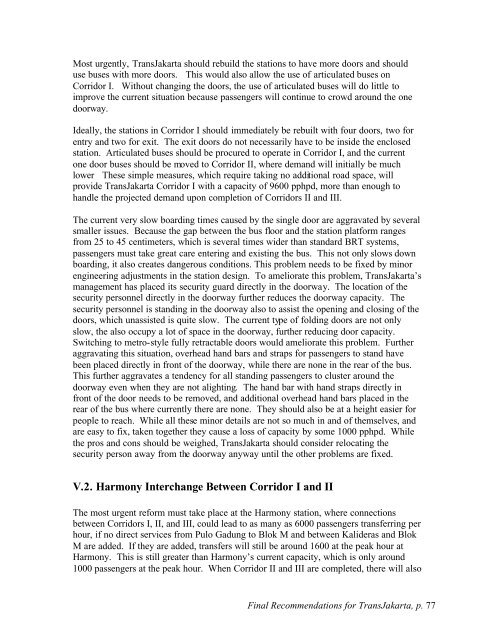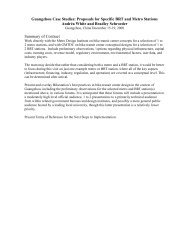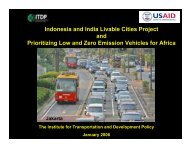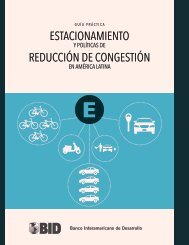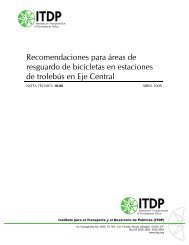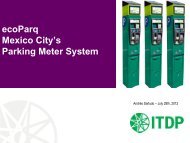Making TransJakarta a World Class BRT System - ITDP | Institute for ...
Making TransJakarta a World Class BRT System - ITDP | Institute for ...
Making TransJakarta a World Class BRT System - ITDP | Institute for ...
Create successful ePaper yourself
Turn your PDF publications into a flip-book with our unique Google optimized e-Paper software.
Most urgently, <strong>TransJakarta</strong> should rebuild the stations to have more doors and should<br />
use buses with more doors. This would also allow the use of articulated buses on<br />
Corridor I. Without changing the doors, the use of articulated buses will do little to<br />
improve the current situation because passengers will continue to crowd around the one<br />
doorway.<br />
Ideally, the stations in Corridor I should immediately be rebuilt with four doors, two <strong>for</strong><br />
entry and two <strong>for</strong> exit. The exit doors do not necessarily have to be inside the enclosed<br />
station. Articulated buses should be procured to operate in Corridor I, and the current<br />
one door buses should be moved to Corridor II, where demand will initially be much<br />
lower These simple measures, which require taking no additional road space, will<br />
provide <strong>TransJakarta</strong> Corridor I with a capacity of 9600 pphpd, more than enough to<br />
handle the projected demand upon completion of Corridors II and III.<br />
The current very slow boarding times caused by the single door are aggravated by several<br />
smaller issues. Because the gap between the bus floor and the station plat<strong>for</strong>m ranges<br />
from 25 to 45 centimeters, which is several times wider than standard <strong>BRT</strong> systems,<br />
passengers must take great care entering and existing the bus. This not only slows down<br />
boarding, it also creates dangerous conditions. This problem needs to be fixed by minor<br />
engineering adjustments in the station design. To ameliorate this problem, <strong>TransJakarta</strong>’s<br />
management has placed its security guard directly in the doorway. The location of the<br />
security personnel directly in the doorway further reduces the doorway capacity. The<br />
security personnel is standing in the doorway also to assist the opening and closing of the<br />
doors, which unassisted is quite slow. The current type of folding doors are not only<br />
slow, the also occupy a lot of space in the doorway, further reducing door capacity.<br />
Switching to metro-style fully retractable doors would ameliorate this problem. Further<br />
aggravating this situation, overhead hand bars and straps <strong>for</strong> passengers to stand have<br />
been placed directly in front of the doorway, while there are none in the rear of the bus.<br />
This further aggravates a tendency <strong>for</strong> all standing passengers to cluster around the<br />
doorway even when they are not alighting. The hand bar with hand straps directly in<br />
front of the door needs to be removed, and additional overhead hand bars placed in the<br />
rear of the bus where currently there are none. They should also be at a height easier <strong>for</strong><br />
people to reach. While all these minor details are not so much in and of themselves, and<br />
are easy to fix, taken together they cause a loss of capacity by some 1000 pphpd. While<br />
the pros and cons should be weighed, <strong>TransJakarta</strong> should consider relocating the<br />
security person away from the doorway anyway until the other problems are fixed.<br />
V.2. Harmony Interchange Between Corridor I and II<br />
The most urgent re<strong>for</strong>m must take place at the Harmony station, where connections<br />
between Corridors I, II, and III, could lead to as many as 6000 passengers transferring per<br />
hour, if no direct services from Pulo Gadung to Blok M and between Kalideras and Blok<br />
M are added. If they are added, transfers will still be around 1600 at the peak hour at<br />
Harmony. This is still greater than Harmony’s current capacity, which is only around<br />
1000 passengers at the peak hour. When Corridor II and III are completed, there will also<br />
Final Recommendations <strong>for</strong> <strong>TransJakarta</strong>, p. 77


